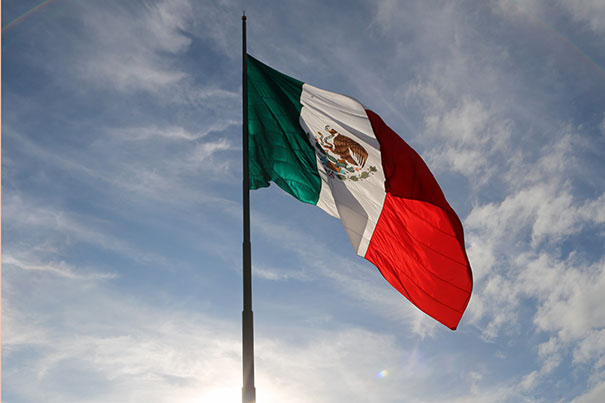
Ned Brown/Harvard Staff
Journey to Mexico
Vignettes showcase visit to that nation by Harvard President Drew Faust, others
Harvard President Drew Faust, University administrators, and faculty members are in Mexico this week for a series of meetings, tours, and alumni events. During their visit to the nation with the largest number of Harvard degree recipients in Latin America, participants are posting items about what they do and see.
FRIDAY, OCT. 24
By Brian D. Farrell
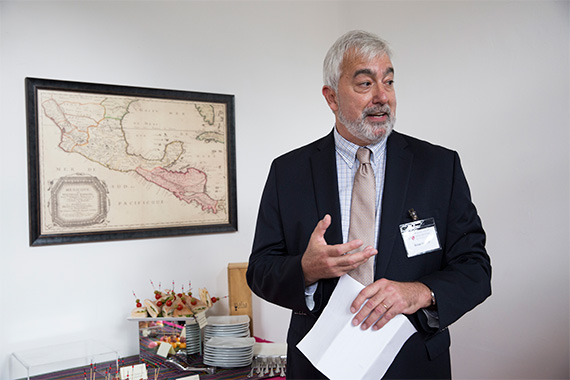
I am a biologist and the new director of the David Rockefeller Center for Latin American Studies (DRCLAS). I first visited Mexico while doing research for my dissertation in 1987. I had rented a VW Beetle, apropos enough, and drove from Mexico City to Jalisco, Michoacán, Guerrero, Oaxaca, and back up through Puebla in search of milkweed beetles, often stopping at archaeological sites visited by earlier entomologists who had discovered my beetle group there in past years.
I was introduced to my future spouse, Irina Ferreras, by a mutual friend from the Universidad Nacional Autónoma de México (UNAM) who was working in the same graduate labs as I did. I later became friends with UNAM Professor Rodolfo Dirzo (now at Stanford). I have several colleagues at UNAM now, specialists on beetles and their host plants. I have visited Mexico many times since, and my early dual experiences of the extraordinary cultural and biological richness here kindled my love and appreciation of the continuity between the arts and sciences.
Since I have been at Harvard these last 20 years, my involvement with DRCLAS has been one of the happiest experiences of my life because it bridges the arts and sciences in a region I love. DRCLAS is Harvard in miniature, bringing together people, students, and scholars from across the University’s Schools and departments, from art and architecture to medicine and public health. Like all Harvard centers, we are a service organization, helping the research and educational interests of the faculty and students, in the context of Latin America.
We partner with Latin American institutions in contexts of mutual interest, and support visits and other educational opportunities in both directions. The DRCLAS Mexico & Central America office started here in Mexico City just 18 months ago with one staff person, program director Patricia Villarreal, M.Ed. ’08, working from home. We have since added program coordinator Gracia Angulo ’10, and our activities are on an exponential climb, with dozens of student internships and partnership areas ranging from venture capital to sustainable development, documentary films to public health clinics.
Our longtime supporters in Mexico and elsewhere in the region had already jump-started our programs from the Cambridge office, and our new office in Mexico City now provides the catalysts of contacts and communication that have attracted new faculty and the students they teach. The office even provides a small but attractive space for talks and seminars, and is a hub for visitors from Harvard to meet with colleagues here. We are proud to complement the 25-year anniversary of the Fundacion México en Harvard, which supports the attendance of so many brilliant Mexican students at our University.
Our 15 partners in Mexico and Nicaragua include the Colegio de México, where students take summer study-abroad courses; Tecnológico de Monterrey and its projects on sustainable development in rural communities throughout Mexico; and INCAE Business School in Nicaragua, where Harvard students work as research assistants. We are excited about the upcoming workshop in Cancun run by Professor Diane Davis of the Graduate School of Design. Partnerships are in development with the Smithsonian Institution in Panama and universities in Costa Rica. DRCLAS Mexico and Central America assists January-term courses, conferences, film screenings, book presentations, and other events of academic interest. We also promote opportunities for Mexican and Central American academics at Harvard.
In short, we aim to serve and nudge forward collaborations of all manner that serve the academic interests of Harvard and this remarkably rich and varied region in Latin America. For me, it is personally enriching to be able to help bring together people and interests in a place that transformed my own professional and personal life.
Brian D. Farrell is director of the David Rockefeller Center for Latin American Studies and a professor of biology in the Department of Organismic and Evolutionary Biology.
THURSDAY, OCT. 23
By Arturo Villanueva ’13
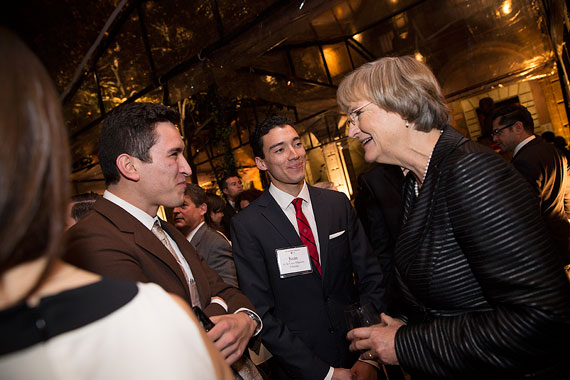
As a recent Harvard College graduate now living in Mexico, I was thrilled to attend “Your Harvard: Mexico” on Tuesday evening. As always, it’s a pleasure to reconnect with the Harvard community from around the world, but I want mostly to give my thanks.
I still remember that day years ago when I came across the Harvard/Princeton/UVA flier, sitting at the Chick-Fil-A in Mission, Texas, where I worked, completely flooded with questions about college. Following the date and hour listed on the flier, I showed up at the information session hosted by the three universities. I arrived at the hotel meeting room, sat, listened, and began to believe. Harvard could be a possibility for me, for my family, and for other students like me.
Harvard changed my life, the life of my family, and of my community. Every experience, from walking onto the varsity lightweight rowing team to serving as a marshal for the Class of 2013, was incredible. Today I am back in Mexico after 16 years, working for the water practice of the World Bank, tackling some of the most challenging water security issues affecting this nation.
I feel fortunate and blessed to belong to such a rich and diverse community as Harvard’s, and to be able to exercise what I learned during my time in Cambridge here in the “real world.”
Arturo Villanueva graduated from Harvard College in 2013.
WEDNESDAY, OCT. 22
By Gracia Angulo ’10

I have a nomadic habit of adopting homes. My trek around the globe began at an early age, when I moved from my native Honduras to Jamaica. Academic pursuits took me to Massachusetts, where I attended Phillips Academy and Harvard College. I graduated in 2010 with a degree in human evolutionary biology and then moved to Paris for my first job after college. This was my convoluted journey to Mexico City, where I arrived a year ago to work with the David Rockefeller Center for Latin American Studies (DRCLAS) in the newest overseas office for Mexico and Central America.
When I was an undergraduate, DRCLAS helped to plant the seed that would lead me to put down roots in this country. The summer after my junior year, I participated in an internship in sustainable development in Cuernavaca, a city about an hour south of Mexico’s capital. My experience that summer influenced my decision to return years later to a country that is rich in culture and full of opportunities, largely due to the energy of its people. I noticed this forward-moving spirit when I was a student, and am even more aware of it now as a staff member working and living here full-time. The interest and willingness of the Harvard alumni in the region to help us make connections and develop ideas has been tremendous and, largely because of this network of doers and thinkers, Mexico has been the perfect springboard for DRCLAS to expand Harvard’s outreach in Latin America.
This past year I have found a way to merge my global penchant and interdisciplinary interests in a region close to my heart. As DRCLAS continues to develop student programs and promote initiatives in Mexico, where we have already received approximately 80 students to date, we also have focused our efforts on expanding our presence in Central America, most recently with a trip to Panama to explore the development of science-focused programs, and where the evolutionary biologist in me got a chance to shine.
I think it is difficult to comprehend how extensive the Harvard community really is. As a student, you are at the center of it — surrounded by Harvard peers and resources on campus. But it is not until you’re thrust outside Harvard Yard that you begin to cross borders, generations, and industries and find that, almost everywhere, there are University alumni who are accessible and ready to help. Tuesday night’s gathering of 500 Harvard community members in Mexico City for President Drew Faust’s visit was a testament to this statement.
My disjointed list of homes continues to grow, with Mexico as its latest entry, but I have come to recognize that this period in my life is more than that, as DRCLAS and Mexico have also become my professional home. It’s a remarkable realization that in my meanderings, all roads eventually lead back to Harvard.
Gracia Angulo graduated from Harvard College in 2010 with an A.B. in human evolutionary biology. She is the program coordinator for DRCLAS Mexico and Central America.
WEDNESDAY, OCT. 22
By Philip W. Lovejoy

As head of the Harvard Alumni Association, I often say I am drawn to this work due to the extraordinary people I meet, and the alumni who are so deeply devoted to Harvard. What’s more, my job allows me the deeply gratifying task of connecting faculty and students to alumni around the world, which — as last night’s Your Harvard Mexico event in Mexico City proved — can be truly magical.
Last night, more than 500 alumni, hailing from nearly every one of Harvard’s Schools, descended on Museo Antiguo Colegio de San Ildefonso Anfiteatro Simon Bolivar to celebrate Harvard and its long and strong ties to this country. They gathered to reconnect with old friends, to make new friends, and to hear President Drew Faust’s vision for Harvard.
The auditorium was home to Diego Rivera’s first mural, “La Creation,” in Mexico. A fitting backdrop for the evening, the mural depicts arts and sciences as the foundations of creation.
A panel discussion on creativity featured Jorge I. Domínguez, University vice provost for international affairs and Antonio Madero Professor for the Study of Mexico; Dean Julio Frenk of the Harvard T.H. Chan School of Public Health; Laura Alfaro, the Warren Alpert Professor of Business Administration at Harvard Business School; Mary Schneider Enriquez, Houghton Associate Curator of Modern and Contemporary Art at the Harvard Art Museums; and alumnus Alejandro Ramirez Magaña. The session explored the role of creativity in economic, business, health, and cultural life.
I was particularly struck by the reflections of Schneider Enriquez, who spent many years living and working in Mexico, on the unique strength of family bonds in Mexican society. After the panel, President Faust detailed the University’s rich and varied ties to Mexico, her vision for the University’s future, and the unique role that alumni play in our Harvard family, with its similarly unshakable bonds. I’ll close as she did: “What we do in Cambridge is enhanced and enriched by the engagement of alumni, the advice of alumni, and the connections that alumni can create for us. Though you have left Harvard, you are still very much a part of what we do.”
Philip W. Lovejoy is executive director of the Harvard Alumni Association.
TUESDAY, OCT. 21
By William L. Fash Jr.

What a privilege to visit the World Heritage Site of Teotihuacan, the “City of the Gods,” with President Drew Faust and my Harvard colleagues. Teo was the sixth-largest city in the world during its heyday from A.D. 100-550, and we discussed the challenges posed for interpretation by a city of this immense size and longevity.
We held a mini-seminar on the history of exploration at the site, the tradeoffs between digging and preserving sites for the future, the changing mores of conservation, and the content and meaning of the amazing dedicatory offerings of the Moon Pyramid.
We next visited the buried architecture of the Quetzal Butterfly Palace, where I pointed out the four-petal yellow flower signs that decorated the pillars of the palace. These are found throughout the city, and are believed by some scholars to be the symbol or even the name of the ancient city.
Brian Farrell, director of the David Rockefeller Center for Latin American Studies and an ecologist with deep knowledge of Mexican flora, fauna, and insects, said four-petal flowers are exceedingly rare, and in that part of Mexico it was likely the evening primrose. President Faust Googled it on her phone and found a picture of such a flower, and we marveled how it looked like the carvings on the palace.
We walked down the grand processional way, called the Avenue of the Dead by the later Aztecs (who reigned supreme in Mexico from 1438 until the arrival of the Spanish in 1517). Then it was on to the immense Pyramid of the Sun, so named by the Aztecs as the place where the “fifth sun” was born, marking the creation of our present world.
Last year Alejandro Sarabia, director of the Teotihuacan Archaeological Zone for the Instituto Nacional de Antropología e Historia, discovered a stone statue of Huehueteotl, the Old Fire God, inside the temple on the summit of the Sun Pyramid, which supports the fire and solar associations of this huge monument.
Similarly, I and my colleagues Alexandre Tokovinine and Barbara Fash recently published a re-analysis of the stone sculptures that adorned the frontal Adosada platform at the base of the pyramid and concluded that the Teotihuacanos (and some distinguished Maya lords) practiced the “new fire” ceremony on the summit of that platform. The Aztecs performed that ceremony every 52 years, to ensure that the fifth sun and our world would not come to an end.
But Eduardo Matos Moctezuma said that the water associations for the Sun Pyramid imbue it with a quite different meaning. Matos discovered a moat around the pyramid, which fills with water each time it rains. In the early 1970s a long, artificial cave beneath the pyramid was discovered, which the ancient Teotihuacanos had dug into the volcanic lava before constructing the pyramid. The cave runs 103 meters into the lava, an important clue because one of the Aztec names for the goggle-eyed rain god Tlaloc was “he of the long cave.”
As the soft rain of Tlaloc lifted, we walked to the summit of the platform. There I shared our hypothesis about the “new fire” ceremony, and how in Teotihuacan times the ceremony was likely to have been performed for the accession of rulers, not just for solar ceremonies. We believe that the Sun Pyramid was dedicated to both fire and the sun, and to water and Tlaloc, not unlike the Aztec Great Temple, which the group had visited the day before. The visit gave all of us much food for thought. For my part, I felt deeply honored to be a part of it.
William L. Fash Jr. is Harvard’s Charles P. Bowditch Professor of Central American and Mexican Archaeology and Ethnology.
MONDAY, OCT. 20
By Julio Frenk
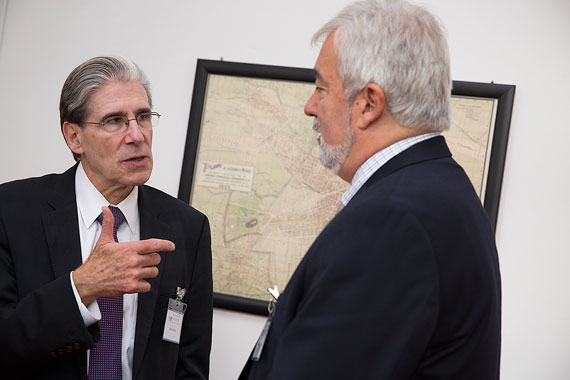
Mexico is not only the beloved country of my childhood, it is also the place that ignited my passion for public health. Later I had the opportunity to put my ideas into action as the nation’s minister of health, a role that continues to inform everything I do today.
My father and his family fled Germany in the 1930s. I would not be alive had they not found a welcoming refuge in Mexico, a country that was poor economically but rich in human spirit and cultural diversity.
Perhaps for these reasons, I grew up with a strong sense of obligation, a desire to give back to the country that had given us so much. That drive found its focus when I was 16 and spent two months in an isolated mountain community in Southern Mexico. At the time, I hadn’t decided whether I would study medicine, like three generations of Frenks before me, or anthropology, and I made this trip to observe a prominent anthropologist in action. One day, an extremely poor woman staggered into our town, carrying a very sick child. She was covered in blood, having injured her head on the trek, so both she and the child were in need of care. But there was no one at the health post — no one at all who could provide the medical aid they needed. For me, this was the turning point. I remember thinking: I am not only going to study these people. I am going to serve these people.
Decades later, when I had the great honor of serving as minister of health from 2000 to 2006, I was committed to finding a way to provide essential health care for everyone, including the poorest and most vulnerable — people like the grandmother and child who had made such an impression on me so many years before. This vision, which at times seemed impossible, would not let go of me, and with the support of many people and institutions (including Harvard University), it ultimately became a reality. Today, the universal health coverage program known as Seguro Popular is firmly established, covering 58 million people.
One of the most critical lessons I took away from this time is the incredible power of good evidence. When we spoke with Mexico’s Congress and other decision-makers in the country, strong evidence made all the difference. No one had any idea how many people were impoverished simply because they had to pay for health care. The peasants forced to sell their land or work implements to pay for medical care were all but invisible. It was only when we conducted a rigorous analysis that this became clear, and that enabled the most important health reform in Mexico in three decades.
This lesson is at the heart of my vision for the Harvard T.H. Chan School of Public Health. Indeed, the unique contribution of this School is the production, reproduction, and translation of knowledge in the form of research, higher education, and outreach. When it comes to public health, there is no conflict between excellence and relevance. Indeed, they are two sides of the same coin, since knowledge is the most powerful force for enlightened social transformation.
Julio Frenk is dean of the Harvard T.H. Chan School of Public Health (HSPH) and is T & G Angelopoulos Professor of Public Health and International Development at HSPH and the Harvard Kennedy School.
SUNDAY, OCT. 19
By Jorge I. Domínguez
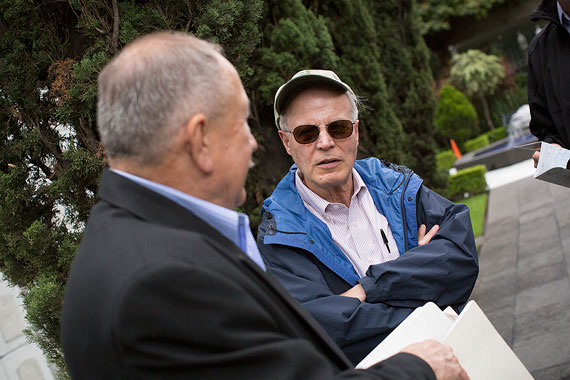
Sixty years ago, two Harvard University professors of botany, working with Mexican and U.S. colleagues, discovered fossilized grains of 60,000-year-old corn pollen 200 feet beneath Mexico City. The discovery established definitively that corn is a native of the Western Hemisphere. Mexicans and their ancestors have cared for corn for centuries, and Harvard and Mexico have been intertwined for the past two centuries in the collaborative search for knowledge.
On Sunday, Harvard University President Drew Faust began her visit to Mexico City, becoming the fifth consecutive Harvard president to do so. She celebrates how much Mexicans have taught Harvard and the world. For example, one of Harvard’s most distinguished appointments in the humanities every year has been the Charles Eliot Norton Professor of Poetry. From Mexico, these have included musical composer Carlos Chávez (1958), architect Félix Candela (1961-1962), and poet Octavio Paz (1971). Harvard’s first Robert K. Kennedy Visiting Professor of Latin American Studies was the novelist Carlos Fuentes, and since then many other Mexicans have held this visiting professorial appointment.
Harvard has learned as well from the thousands of Mexicans who have earned their degrees at the University — 1,722 in the past 20 years, and many others before then. In the fall of 2013, 98 Mexican passport-holders were enrolled in Harvard degree programs (approximately twice the number at the start of the 1990s), the most from any Latin American country, placing Mexico among the University’s top 10 suppliers of students. Upon returning to Mexico, these alumni work across the professions, in music and the arts, in business and in public service, and in universities across the arts, humanities, and the social, life, and physical sciences. Three of the last six presidents of Mexico have been Harvard alumni.
Faust visits Mexico to applaud and express thanks for the extraordinary tripartite collaborations among Harvard’s Mexican alumni, the government of Mexico, and our University. Twenty-five years ago, several alumni in Mexico launched the Fundación México en Harvard to raise funds to enable Mexicans to enroll in Harvard degree programs independent of the applicant’s own or his or her family’s financial means. The five founders, in their statesmanship and vision, established a fellowship program to support Mexican students across dozens of degrees across Harvard’s Schools. Earlier in this century, the Mexican government’s Consejo Nacional de Ciencia y Tecnología (CONACYT) joined Fundación Mexico and Harvard to provide fellowships for Mexican Ph.D. students. Since then, the government of Mexico has been second only to the government of the United States in its support for Harvard Ph.D. students.
Harvard is today one of Mexico’s public universities, open to a hard-working and smart Mexican student regardless of financial means. Thanks to the partnership among Harvard alumni through the Fundación, CONACYT, and the University’s own resources, a Harvard Ph.D. is free to every Mexican who gets admitted. Fellowships for the Ph.D., as for Harvard College, are awarded need-blind and passport-blind: If you are good and you need the funds, welcome! These enlightened alumni, the incumbent and past presidents of Mexico, and the legions who have enabled Harvard to offer such fellowships will pay your full tuition and your costs of lodging and food. Harvard is free to Mexicans from the most modest economic backgrounds.
One of Harvard’s most lasting contributions to Mexico is through research. Professor Alán Aspuru’s research on sustainable energy holds the promise of revolutionizing this field, showing how a Mexican at Harvard adds value to worldwide knowledge and to Mexico itself. Harvard’s capacities have been immeasurably enhanced thanks to the dean of the Harvard T.H. Chan School of Public Health, former Mexican Minister of Health Julio Frenk, who has knitted ever-growing research and educational partnerships between Harvard and Mexico. The world, but especially Mexico, learns from Professor David Carrasco’s research on the Mapa de Cuauhtinchan No. 2, whose 700 images and symbols painted on the large amatl bark paper tell of the migration and settlement of the Chichimec ancestors of the Aztecs through their ordeals, landscapes, and monumental city. Harvard and Mexican scholars have also collaborated over the past two decades to map the public opinion and voting behavior of Mexicans as they invented and enacted a democratic transition that transformed their public life and the nation’s prospects.
In her visit to Mexico, President Faust encounters hospitality, friendship, generosity, and leadership, certain that Mexico has been good for Harvard, hopeful that Harvard has been good for Mexico, and committed to ensuring that Mexico and the University collaborate intellectually to make a better world.
Jorge I. Domínguez is the Antonio Madero Professor for the Study of Mexico and is University vice provost for international affairs.
SUNDAY, OCT. 19
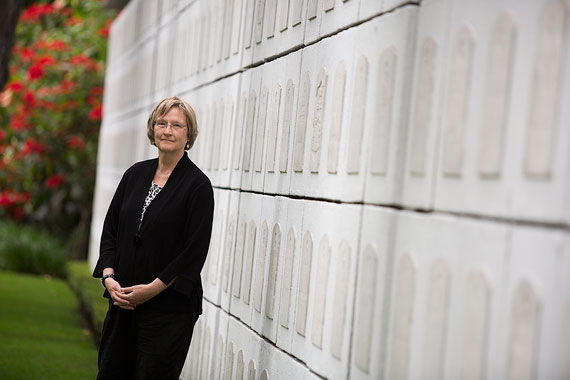
Alongside a busy street in the heart of a modest but bustling Mexico City neighborhood lies a small sanctuary of grass and flowering trees, shielded from nearby traffic by simple white walls covered with 813 names. At one end of the one-acre, rectangular oasis is a burbling fountain. At the other end is a simple white obelisk on a swath of green grass, inscribed at the base with the following words:
To The Honored Memory
Of 750 Americans
Known But To God
Whose Bones Collected
By Their Country’s Order
Are Here Buried
The monument stands over the collective graves of unknown soldiers who fought and died for the United States in Mexico City during the Mexican-American War in 1847. Their remains were transferred to this place in 1851, after the U.S. Congress appropriated funds to ensure a formal burial.
In addition, the 813 names mark the final resting places of the people, mostly Americans, who were interred in the cemetery until it was closed in 1924. Though civilians, many were veterans of the Mexican-American War, as well as of the Civil War, the Spanish-American War, and battles against Native American tribes in the West. Today, the Mexico City National Cemetery is owned by the United States and operated by the American Battle Monuments Commission.
On a cool, gray afternoon, Harvard President Drew Faust toured the cemetery for the first time since learning about it while researching her book “This Republic of Suffering,” and reflected on the historical turning point that these graves represent in how the United States cares for its honored war dead.
American cemetery in Mexico City
Harvard President Drew Faust is the Lincoln Professor of History in the Faculty of Arts and Sciences.




